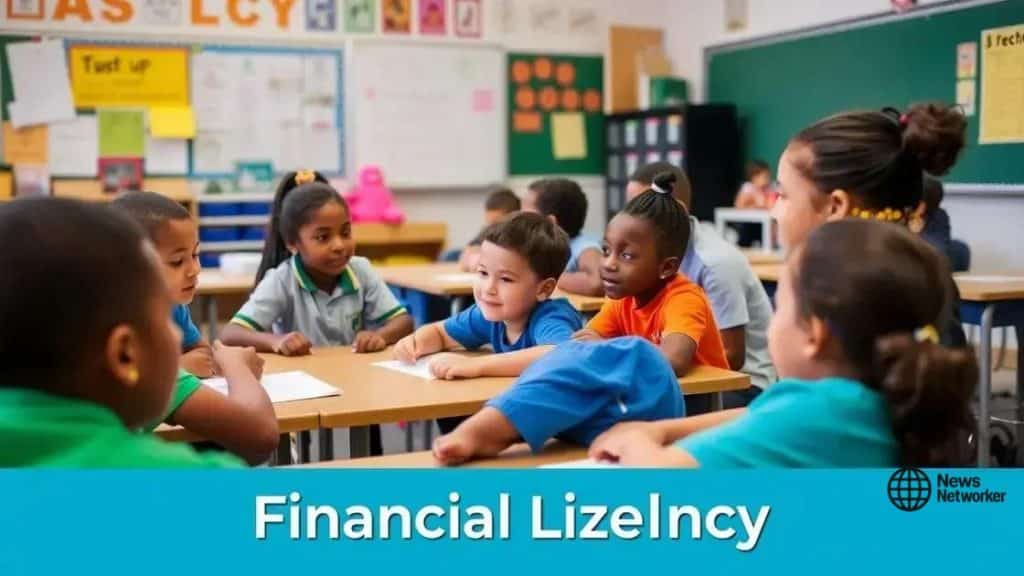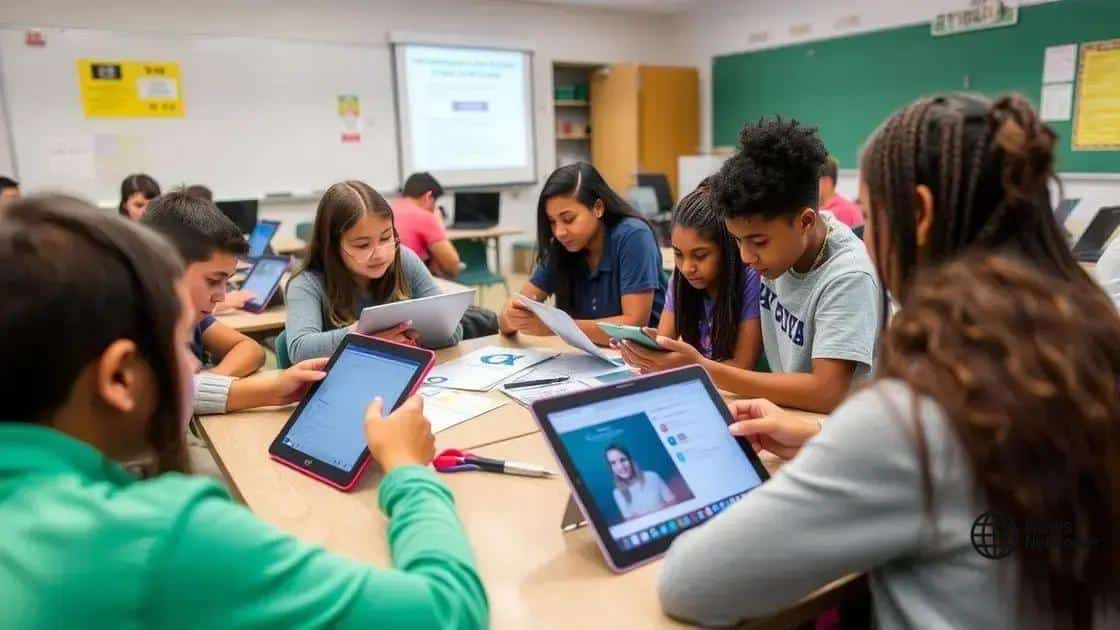Financial literacy in public schools: why it matters

Financial literacy in public schools equips students with essential money management skills, fostering informed decision-making for budgeting, saving, and investing, ultimately promoting financial stability and community prosperity.
Financial literacy in public schools is becoming increasingly vital in today’s economy. Have you ever wondered how well students are prepared to manage their finances? Let’s explore why integrating financial education is essential.
Understanding financial literacy
Understanding financial literacy is the foundation for effective money management. It means being informed about personal finance matters. Schools play a vital role in teaching these essential skills. What does it really mean to be financially literate?
Financial literacy includes various aspects, such as budgeting, saving, and investing. Many students feel unprepared when it comes to handling real-world financial situations. By integrating financial education into school curricula, we can equip them with the necessary knowledge.
Key Components of Financial Literacy
Students should learn about:
- Managing budgets effectively
- Understanding credit and loans
- Saving for future goals
- Making informed investment choices
These components help students develop critical thinking about money. For example, budgeting teaches them how to allocate their resources wisely. Furthermore, when students understand credit, they can make better decisions about loans and interest rates.
Financial literacy also empowers students to set financial goals. They learn to prioritize savings over spending, which is crucial for long-term success. When faced with choices, they can ask themselves: Is this a need or a want? This mindset fosters responsible behavior with money.
Benefits of Understanding Financial Literacy
Understanding financial literacy has numerous benefits. Students who grasp these concepts are likely to:
- Avoid debt pitfalls
- Build substantial savings
- Plan for important life events
- Improve their overall financial well-being
Ultimately, fostering financial literacy in schools creates a generation that is equipped to face economic challenges with confidence. It sets the stage for a brighter financial future for all.
The importance of teaching finance in schools
The importance of teaching finance in schools cannot be overstated. In a rapidly changing economy, students must learn vital skills for managing money. Understanding finance is essential for making informed decisions throughout life.
When students grasp financial concepts, they feel more confident in their choices. For instance, knowing how to budget allows them to manage their allowance or part-time job income effectively. This skill is crucial as they transition into adulthood.
Key Reasons Why Finance Education is Essential
Some reasons that highlight the necessity of finance education in schools include:
- Preparing students for real-life financial challenges
- Helping them avoid common money mistakes
- Encouraging responsible spending and saving habits
- Building a foundation for future financial independence
Financial education teaches students about the implications of debt and the importance of saving for future goals. With this knowledge, they can make informed decisions about loans, credit cards, and investments. It’s crucial for schools to address these topics early on.
Moreover, exposure to finance education fosters critical thinking. When students analyze spending scenarios, they learn to evaluate options and consider long-term consequences. This practice helps build their decision-making abilities. As they grow, this skill will serve them well in various aspects of life.
The Role of Schools in Financial Literacy
Schools must take a proactive approach by incorporating finance into the curriculum. They can offer specialized courses, workshops, or integrate financial discussions into existing subjects. Schools should also provide resources, such as online tools and community programs, to enhance learning.
Teamwork between educators and parents can also strengthen financial education at home. Schools can encourage parents to participate in financial literacy events or provide them with materials to discuss finance with their children. By creating a supportive environment, students can apply what they learn in school to real-life situations.
Practical strategies for schools to implement

Implementing practical strategies for schools to teach finance can greatly enhance students’ understanding of personal finance. Schools must adopt methods that engage students and make learning about finance enjoyable and relevant.
One effective strategy is integrating finance lessons into existing subjects. For example, math classes can cover budgeting and interest calculations, while social studies can include discussions about economic systems. This approach creates connections between finance and real-world applications.
Effective Teaching Techniques
Utilizing various teaching methods can help capture students’ attention:
- Interactive simulations, such as stock market games
- Group projects where students create budgets
- Guest speakers from financial sectors
- Workshops on saving and investing
These activities encourage collaboration and provide hands-on learning experiences. When students participate in simulations, they gain a practical sense of how financial concepts apply in real life.
Another strategy is to encourage financial literacy clubs at school. These clubs can host discussions and workshops about saving, investing, and managing debt. Additionally, they can invite local financial experts to share their insights, making the learning experience richer and more diverse.
Incorporating Technology
Integrating technology can also enhance finance education. Schools can use apps and online resources to teach budgeting and financial planning. For instance, students can learn to create digital budgets or track their spending using these tools. This method not only makes learning interactive but also prepares them for a tech-savvy world.
Furthermore, online resources can provide valuable financial literacy material, making it easier for students to access information anytime. Schools should encourage students to explore financial websites and apps as part of their learning process.
Engaging students in money management
Engaging students in money management is crucial for developing their financial skills. Schools can make learning about finances enjoyable and relevant to students’ lives. When they see the real-world applications, they’re more likely to grasp the concepts.
One effective way to engage students is through practical activities. For example, teachers can organize a classroom activity where students create their own budgets. They can use fake income sources and then decide how to allocate their funds for various expenses. This hands-on approach makes the learning experience immersive and impactful.
Utilizing Real-Life Scenarios
Another strategy is to introduce real-life scenarios. Students can work on projects that involve planning for a year, such as:
- Planning a trip with a budget
- Choosing a college and estimating living expenses
- Creating a plan for a part-time job’s earnings
By using these examples, students can visualize how financial management affects their daily lives. It also helps them think critically about the decisions they make with money.
In addition, promoting discussions about financial responsibility can spark interest. Teachers can encourage students to talk about personal experiences, such as saving for a desired item or managing a weekly allowance. This sharing fosters a connection and shows that money management is relevant for everyone.
Incorporating Technology into Learning
Technology can also play a significant role in engaging students. Schools can use apps and online games that teach financial principles through interactive gameplay. These tools can make learning fun while reinforcing key concepts around budgeting and saving.
Moreover, financial literacy platforms can provide students with real-time data on saving and investing. With these resources, students can follow trends and apply their knowledge in a virtual setting, enhancing their understanding of money management.
Real-world implications of financial literacy
Understanding the real-world implications of financial literacy is vital for students. It goes beyond classroom lessons and affects their daily decisions and future opportunities. When students are financially literate, they feel empowered to make informed choices that can lead to a stable and prosperous life.
For instance, financially literate individuals are better at managing everyday expenses. They understand the importance of creating a budget and sticking to it, which helps them avoid unnecessary debt. This skill becomes increasingly important as they enter adulthood and start handling larger financial responsibilities.
Impact on Personal Finance
Financial literacy has a direct impact on personal finance management:
- Effective budgeting helps in achieving short-term and long-term goals.
- Understanding credit scores can lead to better loan terms.
- Savvy investments can grow wealth over time.
- Awareness of financial scams protects them from losing money.
When students learn to navigate these aspects, they develop healthier financial habits that can last a lifetime. They learn to differentiate between needs and wants, which is essential for making sound financial decisions.
Another important implication is the impact on employment opportunities. Employers often look for candidates who can demonstrate financial responsibility and problem-solving skills. A solid foundation in finance can set students apart in competitive job markets. Furthermore, those with financial knowledge are more likely to negotiate salaries and benefits effectively.
Community and Economic Benefits
On a broader scale, communities benefit from individuals who are financially literate. When more people understand finance, it can lead to greater economic stability. Financially savvy citizens contribute to local businesses and invest in their communities.
Moreover, reduced reliance on credit can decrease economic vulnerability during downturns. When individuals make informed financial decisions, they help create a stronger, more resilient economy that can weather challenges.
FAQ – Frequently Asked Questions about Financial Literacy in Schools
Why is financial literacy important for students?
Financial literacy is essential because it equips students with the skills to manage money effectively, avoid debt, and plan for their future.
How can schools effectively teach financial literacy?
Schools can teach financial literacy by integrating finance into existing subjects, using hands-on activities, and incorporating technology and real-life scenarios.
What are some practical strategies for engaging students in money management?
Practical strategies include creating budgets, discussing personal financial experiences, and utilizing interactive apps and games related to finance.
What benefits does financial literacy have on the economy?
Financially literate individuals contribute positively to their communities and promote economic stability by making informed financial decisions.





